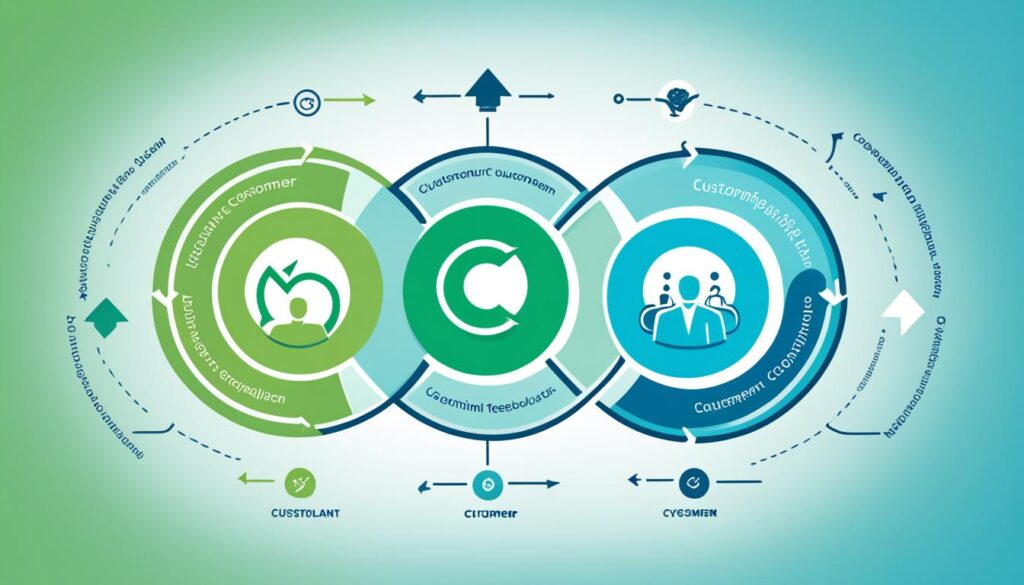Have you ever thought about turning customer complaints into chances for growth? It’s common knowledge that quick and efficient handling of customer complaints is key. But, do you know how to do it effectively?
Complaints are not just problems; they can help you get better. They offer insights to improve products, services, and the customer’s overall experience. With the right plan, you can turn an unhappy customer into a loyal fan.
This article will show you five key steps for dealing with complaints well. Each step will help you manage the complaint, handle feedback, and solve the problem. In the end, you’ll learn how to ensure customer satisfaction.
Key Takeaways:
- Handling customer complaints efficiently is crucial for maintaining customer satisfaction.
- Customer complaints can provide valuable insights for improving products and services.
- Addressing customer complaints promptly and effectively can turn an unhappy customer into a loyal advocate.
- These five steps will guide you through the process of complaint resolution and customer satisfaction.
- Stay tuned to learn the best strategies for handling customer grievances efficiently!
Understanding Customer Complaints as Opportunities
People often see customer complaints as bad for business. But if we handle complaints well, they can become chances to make our service better. And we can make our customers like us more.
The Service Recovery Paradox
The service recovery paradox sounds fancy, but it’s simple. Fixing a complaint can make the customer like us more than before. When we make a dissatisfied customer happy, they are likely to stick with us and tell others about their good experience.
This paradox shows that dealing with complaints well can turn unhappy customers into our biggest fans. Listening and acting are key steps.
Uncovering the Disconnect
To solve complaints effectively, we must first figure out what’s really wrong. This means looking closely at what customers say and pinpointing where we need to improve.
By studying customer feedback, we can see where we’re falling short. This insight helps us know exactly where to focus our efforts.
Finding these weak spots lets us make targeted changes for the better. We can fix problems and make our service shine.
| Benefits of Turning Complaints into Opportunities | Steps to Effectively Handle Customer Complaints |
|---|---|
|
|
5 Steps to Handling a Customer Complaint
Great customer service means having a clear way to tackle complaints. This ensures every complaint gets solved well, making customers happy. We’ll show you five steps for handling complaints brilliantly.
Step 1: Understand the Complaint
Listening to a complaint is the first step. You need to show you care and really get what’s bothering the customer. Understand what they say, what went wrong, and any proof they have.
Step 2: Acknowledge and Apologize
Once you get the complaint, say sorry quickly. Showing empathy and taking responsibility early can calm the situation. This shows you’re serious about making things right.
Step 3: Investigate and Take Action
Time to dig deeper into the problem. Chat with other staff or dig into records to get the full picture. Then, fix the problem, like giving a refund or stopping it from happening again.
Step 4: Communicate the Resolution
Stay clear and quick in your updates with the customer. Let them know what’s happening and what you’re doing to fix it. This builds trust. Answer their questions fast.
Step 5: Follow Up and Ensure Satisfaction
Check in after solving things to make sure they’re happy. This step is super important but often not done. Ask for feedback to keep getting better. Making sure they’re satisfied can turn a bad experience good.

Initiating the Problem-Solving Process
When a customer has a complaint, acting quickly is key. Businesses need to start by asking the right questions. This helps understand fully what the customer is upset about and what they want. It’s crucial to dig deep to find the real issue so that the solutions are right on point.
Asking key questions is a big part of the fix. It pulls together the important facts to find the heart of the problem. Listening and making sure you get what the customer is saying shows you want to help. It’s the first step towards solving the issue.
Knowing what the customer expects is very important. Spend time figuring out what they thought they’d get from your product or service. This lets businesses match their solutions to what the customer hoped for. It’s how you make things right in their eyes.
Using a smart approach helps solve complaints better. It’s about asking the right questions and totally getting what the customer expects. This way, businesses can ace at their service and make customers really happy.
Problem-Solving Process for Customer Complaints
| Step | Description |
|---|---|
| 1 | Listen actively to the customer’s complaint and ask clarifying questions to gain a thorough understanding. |
| 2 | Analyze the customer’s expectations and how they align with the product or service provided. |
| 3 | Identify the root cause of the complaint by conducting a detailed investigation or analysis. |
| 4 | Develop tailored solutions that address the underlying problem and meet customer expectations. |
| 5 | Implement the solutions and communicate effectively with the customer throughout the resolution process. |
Identifying Types of Unhappy Customers
Not all unhappy customers express their feelings in the same way. It’s key to know the various types to deal with complaints right. By looking closely at what each group needs, companies can respond better to their unhappy clients.
Confrontational Customers
Some customers are openly unhappy and can be forceful. They might demand fast solutions and use strong language. When facing these situations, staying calm and listening well is crucial. Businesses should aim to resolve issues peacefully and quickly.
Demanding Premium Support Seekers
There are those customers who expect top-tier service because of their loyalty or membership. They’re ready to pay more for special attention. Offering them quick solutions and exclusive perks is essential for their satisfaction.
Frequent Flyers of Customer Service
Some people need help often due to repeated issues or special needs. For these customers, identifying the root problems and providing ongoing support is key. Businesses must work to make resolving complaints smoother and more efficient.
Non-Complainers at Risk of Churning
Then there are customers who are quiet about their unhappiness. However, their silent dissatisfaction can threaten a business’s success. To keep them from leaving, companies need to stay ahead. By understanding and meeting these silent customers’ needs, defection can be prevented.

Customer Behavior Analysis and Segmentation
Customer behavior study helps companies know what their clients like and what causes them problems. This helps them improve their services. By looking at what customers buy and what they say, companies can group them into types.
Breaking customers into groups lets businesses target their needs better. By doing this, companies can make each customer feel special. This can lead to happier customers, more loyalty, and more sales. It also helps in tailoring specific solutions for different types of customers.
| Segment | Characteristics | Strategy |
|---|---|---|
| Confrontational Customers | Expresses dissatisfaction openly and assertively | Provide active listening, empathy, and timely resolutions |
| Demanding Premium Support Seekers | Expects personalized attention and expedited resolutions due to status or loyalty | Offer exclusive benefits, quick responses, and prioritize their concerns |
| Frequent Flyers of Customer Service | Encounters recurring issues or has high interaction volume with support | Proactively address recurring issues, streamline resolution processes |
| Non-Complainers at Risk of Churning | Does not express dissatisfaction but poses a risk of switching to competitors | Proactive monitoring, reaching out, and addressing their needs |
Swift Responses to Customer Grievances
When customers complain, time is crucial. A quick response is key to keeping them satisfied and loyal. It shows that you care about their concerns and want to fix any problems. Plus, it stops bad news about your business from spreading.
In our digital age, people expect fast answers to their issues. A quick reply not only solves their problem but also makes them feel heard. It can make unhappy customers become big fans of your brand.
To respond fast, start by acknowledging their complaint. Use any way possible, like email or social media, within 24 hours. Show you understand their frustration and want to help.
After saying you’re on it, keep them updated as you solve the problem. Sharing your progress helps build trust. It shows you’re working on it and care about making things right for them.
Quick responses affect more than just the current issue. They shape how people see your business overall. Happy customers might even tell their friends good things about you.
So, by being quick with complaints, you can set a strong foundation of trust with your customers. It prevents problems from getting worse and builds long-term relationships.
Proposing Solutions to Customer Complaints
Handling customer complaints well is key for businesses. By solving issues quickly, they can make upset customers happy again. This part highlights why clear communication and checking satisfaction are so vital.
Effective Communication of Resolutions
It’s essential to communicate clearly when solving complaints. Businesses must tell customers how they’re fixing the problem and what they’ll do to make it right. This could be through calls, emails, or online chats. Good communication ensures customers know their issues are being taken seriously.
Being upfront and offering real solutions helps manage what customers expect. By sharing when things will be fixed or any limits, businesses show they care. This builds trust and often makes customers even happier in the end.
Confirming Satisfaction Post-Resolution
Once a solution is shared, it’s important to check if the customer is happy. This means getting in touch to see if the fix worked and how they feel. It’s a chance for businesses to see if their help was effective.
Businesses can use emails or surveys to see if customers are satisfied after the fix. This feedback is gold for improving how they handle complaints. Plus, if a customer is happy, it shows the business is focused on doing better.

Good complaint-solving not only stops immediate issues but can also build loyal customers. Making sure customers understand and are happy with the solution is key. Let’s look at how businesses can stop complaints from happening again in the next section.
Preventing Recurrences Using Customer Feedback
Listening to customers is key to better services and less complaints. When companies take customers’ concerns and suggestions seriously, they get important insights. These insights help in planning service improvements.
Logging and Monitoring Complaint Trends
Businesses need to track and understand complaint trends to stop issues from happening again. They should look closely at customer feedback. This helps to spot common problems and why customers are not happy. By doing this, businesses find out what needs to change.
Improving Services Based on Feedback
After finding out about complaint trends, companies can fix the major issues. By dealing with the main causes of these complaints, they make customers happier. This also stops the same problems from coming back in the future.
Improving services never stops. Companies have to keep listening to customers and making changes. They should regularly check if these changes make customers more satisfied. This way, businesses build trust with customers and improve their own image.
Building a Culture of Positive Customer Service
Starting a culture of great customer service involves customer-centric culture and customer service mindset among workers. It makes businesses focus on customer needs. Customer enjoyment becomes the top goal, leading to satisfied customers who come back.
For a customer-focused culture, training employees in customer satisfaction is crucial. They learn skills to solve issues and give great service. This includes active listening, solving problems, and clear communication.

Businesses could offer rewards to keep their staff thinking about customer service. This might include bonuses or chances to grow their careers based on making customers happy.
Encouraging workers to truly own customer problems is key too. They are motivated to do whatever it takes to meet customer needs.
Keeping open lines of communication helps employees feel valued. You can use meetings, suggestion boxes, or ways to give feedback without sharing your name.
With a focus on great customer service, businesses can avoid many complaints. This leads to happy customers who come back, helping the business grow.
Nurturing Client Relationships Post-Complaint
After solving a customer’s complaint, the relationship upkeep starts. It’s perfect for strengthening how you manage relationships after a complaint. Using great strategies to follow up can make sure customers stay happy and become loyal fans.
Following Up for Lasting Satisfaction
It’s key to check in after fixing a complaint. It shows customers their thoughts matter and you want to keep them happy. Personalized messages or surveys help you learn more, see how they feel, and fix any issues left.
Expressing thanks for their feedback during follow-ups is important. Saying what you did to fix the issue shows their opinions count and make things better. It also lets you learn how you can improve more from their feedback.
Turning Detractors into Promoters
Fixing complaints well is vital, but making customers really happy is better. Offer more than they expected to impress them. Going the extra mile can turn unhappy customers into your biggest fans.
One way to do this is offering something extra special after a complaint that makes them remember. It shows you care about making them happy. These customers might start telling people how great your business is.
Being active on social media can also help. Respond to complaints there, showing what you did to help. This proves you’re open about fixing problems and care about people’s happiness.
Keeping in touch after complaints and making unhappy customers happy are big steps. They help your business be about keeping customers satisfied and loyal.
Conclusion
Handling customer complaints well is key for making customers happy and forging strong ties. By using the steps and strategies we’ve talked about, companies can shine by offering top-notch service during complaint situations.
We’ve looked at the paradox of service recovery, the gap between what customers want and what they get, and different unhappy customer types. Responding quickly, finding the right fixes, and preventing similar issues are crucial. This is all done by listening to what customers have to say.
Keeping track of complaints can help businesses spot areas needing work. This way, they improve their overall service. Not only do they fix current issues, but they also stop new ones from popping up.
Creating a team that cares about customers and their needs, even after a complaint, can boost loyalty and positive word-of-mouth. Always see a complaining customer as a chance to make things right and win their hearts for the long haul.
